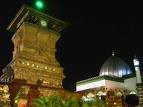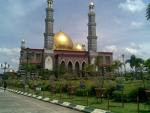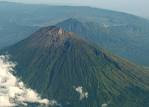
Ratu Boko is an archaeological site known to modern Javanese as Kraton Ratu Boko or Ratu Boko's Palace. Ratu Boko is located on a plateau, about three kilometres south of Lara Jonggrang Prambanan temple complex in Yogyakarta Indonesia. The original name of this site is still unclear, however the local inhabitants named this site after King Boko, the legendary king mentioned in Loro Jonggrang folklore.
The site covers 16 hectares in two hamlets (Dawung and Sambireja) of the village of Bokoharjo and Prambanan. The remains of settlements also founds in Ratu Boko vicinity. This site is located 196 m above the sea level, on the highest point in the site, there is a small pavilion from which one will be able to see a panoramic view of Prambanan temple with Mount Merapi as the background.
At Ratu Boko traces of probable secular structures were erected on a plateau divided into terraces separated from each other by stone walls and stone-faced ramparts (talud). The site was reached by a steep path up the northwest slope of the plateau, in the direction of Prambanan. The structural remains in the terrace at Ratu Boko site consist of places with folk names connected with palaces such as paseban (reception pavilion), pendopo (audience hall) and kaputren (women's quarter). A pool complex lies on a terrace adjoining the east side of the pendopo. A group of artificial caves, probably for meditation, lies to the north, isolated from the rest of the site. These archaeological sites are:
Main Gate
The first of three terraces is reached through a massive gateway built on two levels. On the western edge of this terrace is a high talud of soft white limestone. The second terrace, separated from the first by andesite wall, is reached through a gateway in paduraksa form consisting of three doors, a larger central one flanked by two of lesser dimensions. The third terrace, the largest, contains the richest concentrations of archaeological remains. It is read on the main gate Panabwara that was written by Rakai Panabwara, descendant of Rakai Panangkaran. He carved his name there in order to legitimate his authority of this palace.
Candi Batu Putih
Literally, Batu Putih means white stone. It is a structure made from white limestone on the north side of the first row of the gate on second terrace.
Candi Pembakaran
Beyond the second row of gates on third terrace, on the north side of the plateau there's a structure similar to the base part of the temple with two terraces about 26x26 m in size. On the center of upper terrace is just an empty descending square hole. The function of that building probably as the crematorium to burn the corpses.
Paseban
On the plateau on third terrace, beside the Candi Pembakaran, there's also several square stone structure. On the structure there's some umpak or stone serve as the base of wooden column with hole to erect the pillars.
Pendopo
On the second terrace on the southeast side of the plateau, lies the pendopo (audience hall). The pendopo is a square stone enclosure surrounded with andesite stone wall with the small paduraksa entrance gates in north, west, and south side of the walled enclosure. In the center of this walled enclosure there's a stone base formed by two separated terraces, the terrace in the southern side is smaller than the north side one. This terrace served as the base and floor of the wooden structure since there's some umpak or stone serve as the base of wooden column with hole to erect the pillars.
Miniature Temples
On the south side on the pendopo, there's three miniature temples with square stone basin in front of it. This small temple probably serve the religious purpose, as some kind of Hindu or Budhist shrine in the Ratu Boko complex.
Kaputren and Bathing Place
On eastern side of pendopo on lower terrace, there is several andesite stone walled enclosure with paduraksa gate and gallery lead to the several pool within the walled enclosure. This structure is associated by local folks as kaputren (women's quarter), since the pool believed to be the pleasure garden for king and his concubines. One particular pool (or well) within the bath place is considered sacred by Hindu people called 'Amerta Mantana'. It is believed that the water of Amerta brings luck for anyone who uses it. Hindu people use it in Tawur Agung ceremony, one day before the Nyepi day, to support the achievement of self purify and to return the earth into her initial harmony. To the east of the pool there's two stone base structure, yet again probably the remains of wooden structure which only the stone base still remains.
Ascetic Cave
At the northern part from pendopo, isolated from the rest of the site, lies two caves that were formed of sediment stones. The upper cave is called Gua Lanang (Male Cave) and the lower cave is called Gua Wadon (Female Cave).
Buddhism and Hinduism
Ratu Boko site has yielded many smaller artefact including statues, both Hindu (Durga, Ganesha, Garuda, a Lingga and a Yoni) and Buddhist (three unfinished Dhyani Buddhas). Other finds include ceramics and inscriptions; a golden plate with the writing "Om Rudra ya namah swaha" on it as form of worship to Rudra as the other name of Shiva.
Functions
Despite the large quantity and variety of remains found there, the exact functions of Ratu Boko site is still unknown. Some believe it was the former palace of ancient Mataram Kingdom; other scholars interpret this site as monastery. Five inscriptions in pre-Nagari script and Sanskirt describe the construction of a shrine for Avalokitesvara.
The Legend of King Boko
King Boko is a legendary character known from popular folklore of Loro Jonggrang. This folklore connects the Ratu Boko Palace, the Durga statue in Prambanan temple (which is identified by local folklore as Loro Jonggrang), and the origin of the Sewu temple complex nearby. Prince Bandung Bondowoso loved Princess Loro Jonggrang, the daughter of King Boko, but she rejected his proposal of marriage because Bandung Bondowoso had killed King Boko and ruled her kingdom. Bandung Bondowoso insisted on the union, and finally Loro Jonggrang was forced to agree for a union in marriage, but she posed one condition: Bandung must build her a thousand temples in one night. He entered into meditation and conjured up a multitude of spirits (genies or demons) from the earth. They succeeded in building 999 temples. Loro Jonggrang then woke her palace maids and ordered them to begin pounding rice. This awoke the roosters, which began to crow. The genies, hearing the sound of morning, believed the sun was about to rise and so disappeared back into the ground. Thus the prince was fooled, in revenge he cursed the princess and turned her into a stone statue. According to the traditions, she is the image of Durga in the north cell of the Shiva temple at Prambanan, which is still known as Loro Jonggrang or Slender Virgin.














































